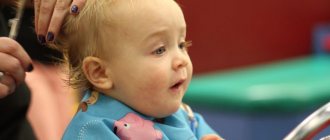: Reading time:
Does your child often worry, cry at the slightest provocation, or seem clumsy or lazy to you? What have you tried: sorry, scolded, talked, turned to educators or teachers for help? And nothing! Nothing helps at all? It’s so exhausting when you try, twist and turn, and everything goes down the drain. To nothing. It happens. And it happens quite often when, not knowing the reason for what is happening, you begin to correct, correct, bend in the other direction. And the harder you bend, the more likely it is that you won’t guess the direction and will break it.
One of the most important characteristics of children is the degree of left-handedness. It is not for nothing that determining the dominant hand is a key component of neuropsychological diagnostics. This characteristic speaks volumes: about the peculiarities of speech development, about the choice of one or another method of receiving, processing and analyzing information.
From the age of four or five, parents themselves notice that the child began to perform most actions with just one hand. Before this age, the dominant hand may change. For example, a child always has a spoon in his left hand, and he also draws with his left hand. What if it’s not so obvious? Does he eat with his left hand and put his pencil on his right? Or does he do everything predominantly with his right hand, but picks up scissors with his left hand? In addition, in psychology there is the concept of “pseudo-left-handedness,” that is, compensatory left-handedness. It can occur even before birth if, for example, the left hemisphere of the brain was damaged or in early childhood, for example, with an injury to the right hand.
“Hidden left-handedness” - what is it?
You've probably heard about such a thing as “hidden left-handedness”? It is often found in popular psychology. What do they mean by this? A person basically does everything with his right hand, but it is more convenient for him to perform some actions with his left. In fact, absolute right-handers or left-handers are not that common. Moreover, even adults are sometimes surprised to discover that they do something with their left hand. For many years they simply did not pay attention to it. For example, a person considered himself absolutely right-handed, but suddenly noticed that it was more convenient for him to hold a needle with his left hand. It’s just that this action, unlike writing, was not given attention in childhood. Many people who are right-handed dominant have one or more characteristics of left-handedness.
You can try to determine your child’s dominant hand at home using the M. Ozyas questionnaire. The examination scheme consists of tasks that the child is asked to complete. In this case, if the right hand is dominant, 1 point is given. If it is left, no points are given. In total, Ozyas offers 20 tasks, among which are the following: screw caps on bottles, pour water from one vessel to another, hit a small point with a needle, etc. To determine the hand for writing, Ozyas draws attention to 10 actions that, according to the author, are unusual for a child, and therefore give the most accurate picture.
Offer your child the following actions as a game:
- light matches
- pin, string buttons, beads,
- pour water from one vessel to another,
- pierce holes (5-6 blows),
- lay out (distribute) cards (cards),
- erase the previously drawn crosses with an eraser,
- drop from a pipette into the narrow opening of the bottle,
- clean yourself, shake off specks, dust,
- remove the bead from the glass with a spoon,
- ring a bell, pull the bell cord.
Why should you know that your child is left-handed? At least to tell the teacher about this when entering first grade. Left-handed children are recommended to be seated at a desk in the first column on the right (relative to the teacher). At the desk they are placed to the left of the neighbor so that the children do not bump into elbows. When learning, left-handed children often experience mirror writing and other characteristics. In addition, unfortunately, not all teachers yet know about the dangers of relearning from the left hand to the right. But this is just the tip of the iceberg. What's underwater?
How to identify left-handedness at an early age?
Determining the leading hand
Almost all children in the first two years of life are ambidextrous, that is, when performing various tasks they actively use both hands: they can hold things, fasten buttons, open doors with either their left or right hand. Then this “skill” fades away, the child becomes right-handed or left-handed. Among adults, ambidextrous people are extremely rare.
So, until the age of two, the baby will use both hands almost equally. However, it is possible to determine which of them will become the leader much earlier - at four months. At this age, innate reflexes fade away, the child begins to make movements with his hands more consciously.
To figure out whether your baby will grow up to be right-handed or left-handed, do six simple exercises with him (present them in the form of a game so that the baby finds it interesting):
- Ask him to clap his hands. Observe which hand the child uses more intensely.
- Have your baby take the rattle and tap it on a hard surface.
- Together with your child, stroke the toy, saying how good it is (well done for going to the potty or brushing your teeth).
- Ask your child to open the jar and put an object in it.
- Have the child cup his hands and cross his fingers into a “lock” (the thumb of his dominant hand is on top).
- Ask the baby to cross his arms over his chest (the hand of the leading hand will lie on top, on the forearm of the passive one).
Important! You can do without exercise. It is enough to watch the baby. The hand that first begins to lose its innate reflexes (for example, grasping) is likely to become the dominant one. However, tracking this process is not easy.
Do I need to retrain?
People with a dominant left hand are uncomfortable in the company of right-handed people. They have to adapt for a long time to using household appliances, equipment, furniture, and clothing. Left-handed children learn to read and write more slowly. However, modern experts and teachers strongly do not recommend retraining left-handed children. The fact is that the learning process will affect various physiological processes and brain function, and this can lead to high emotional excitability of the child, neuroses, migraines, and delayed speech development.
Therefore, it is better to accept the baby as he is and help him feel comfortable in the right-handed world. To do this, you need to properly organize his personal and work space, engage in educational games with the child (pay attention to fine motor skills, coordination of movements, visual perception), and use visual materials (drawings, graphs) when teaching.
Important! Your baby's life will be made easier by items designed specifically for left-handed children. Today they can be easily found in various online stores.
The role of a neuropsychologist in determining the child’s dominant hand
There are no “universal” children, which means there are no “universal” recipes for healing. Symptoms of disorders may be similar. But, if you dig deeper, their nature will differ significantly.
For example, let’s take two five-year-old children. Let's say their names are Vanya and Misha. The parents of both boys complain that their son is inattentive, capricious, and often cries. Vanya’s parents read somewhere, asked around somewhere and decided that it was a matter of daily routine. They started putting Vanya to bed earlier, he began to watch less TV and go for walks more. Vanya became much calmer. The parents, satisfied with themselves and their son, told Misha’s parents about their experience. From that day on, Misha also began to go to bed at nine, walk for hours and watch TV for 20 minutes a day. But the boy still cries for any reason, and during class he “counts crows.” Parents are perplexed: “We did everything right! Why didn’t it help?
In many cases, neuropsychological diagnostics clarifies the situation. And then it may turn out that it’s not a matter of daily routine at all, but rather the peculiarities of the interaction of certain parts of the brain. One of the characteristics of this interaction is which hand the child prefers to use. Therefore, neuropsychologists take a thorough approach to determining the leading hand. This information helps to find optimal solutions in the development and education of children.
The child is left-handed. Causes
The most common reason is hereditary, when one of the parents is left-handed. Left-handedness in this case is the norm, an individual development. Both hemispheres of the brain are healthy and perform their functions, but the right hemisphere dominates, responsible for the left side of the body. There are no problems, except that the world is right-handed. Parents need to take into account the child’s characteristics, help him, and he himself will quickly adapt to the right-handed world. Such children are no different from right-handed children either in psyche or development.
The second cause of left-handedness is damage to the left hemisphere of the brain in the prenatal period or in connection with some illness in infancy, or during difficult childbirth. The left hemisphere cannot function normally, and the right hemisphere takes over its function. The consequence of these reasons is left-handedness. The body tries to compensate for the missing functions of the left hemisphere and makes the right hemisphere dominant. Such a child often has problems with speech development, learning, and motor skills. The right hemisphere works “for two”. It’s already difficult for a child, but if you start retraining him, a disaster could happen. This can lead to mental disorders, enuresis, nervous tics, stuttering, digestive problems, weakened immunity, etc. Fortunately, now in schools they do not fight against left-handedness, they do not re-educate them like 30-40 years ago.
The third reason for left-handedness is forced, for example, associated with an injury to the right hand. And not even for the child, but for his parent. There are many examples of this when the children of fathers who returned from the war, who had lost their right hand, looked at them and did everything with their left hand “like dad.” If the child himself has an injured hand, and he protects it by doing everything with his left hand, then after the right hand has recovered, unobtrusively encourage the child to use it. Gradually, right-handedness will return. A child should only be retrained from his left to his right hand by imitating a left-handed relative. In the other two cases, it is absolutely impossible to retrain a left-handed child.
There are cases of pseudo-left-handedness when the dominant hemisphere of the brain is not identified. Then the child uses both hands equally. This occurs due to an immature connection between the left and right hemispheres of the brain. In this case, it is necessary to consult a neuropsychologist. The specialist will conduct classes during which the dominant hemisphere of the brain will be identified, in most cases the right. The specialist has techniques that allow him to do this quite quickly, in just a few sessions. By the age of ten, many children determine their dominant hemisphere without any help. But sometimes this does not happen and additional help is needed, so it is better to identify the child’s status earlier.
Is Lefty a man of mystery?
Quantity Leave your comment
SHARE
Photo from the gallery “My Sunshine”
The human body is a big mystery for the person himself. Who is a left-hander? This is a person whose right half of the brain is dominant.
Usually one half of the brain dominates, and crossover occurs, i.e. The right half of the human body is controlled by the left hemisphere, and the left half by the right. Scientists have identified degrees of dominance: strongly expressed (“one hundred percent” right-handed or pronounced left-handed) and weakly expressed (there may be 1-2 signs of “left-handedness” - the dominant left eye and left ear, but the dominant hand is the right).
And people who are so-called ambidextrous, in whom both hemispheres work equally, are equally good at using both hands, ears, eyes, i.e. paired organs. There are few such people, but, according to scientific research, their number is constantly growing.
How to find out what type a person belongs to? Below I will give tests, but for now – general characteristics.
If a person is “one hundred percent” right-handed, he exhibits the following signs:
- writes and performs most actions, especially complex ones, with the right hand,
- puts the phone receiver to the right ear,
- leading eye, ear - right,
- the leading leg is also the right one (it is a pushing leg, a person begins to walk from it)
If at least one of these signs has a mirror image (with the right hand leading, the left ear hears better, for example) - this is more (or less) pronounced left-handedness.
Scientists call such people “hidden left-handers.” Scientists who conducted research to identify obvious and hidden left-handers found that such people make up 62%! That is, more than half of healthy people! Although the percentage of left-handers to right-handers differs slightly among different researchers, it still turns out that left-handers make up about half of the general population.
Most people are “partial” left-handed (i.e., the dominant hand is the left, and the dominant eye, for example, is the right).
In young children, latent left-handedness and obvious signs of the leading right hemisphere are observed much more often than in adults. Also, children often speak equally well with both their left and right hands, i.e. are ambidextrous. It is believed that before the age of one year, the foundation for brain development is laid, and the leading hemisphere is formed by 6-7 years, but already at 4 years old one can confidently say which hand is the baby’s dominant.
Scientists have identified several causes of left-handedness in children (although they are not completely proven and controversial):
- birth stress (the presence of at least two unfavorable factors, including low weight of the newborn, too fast or prolonged labor, the use of obstetric instruments, asphyxia in the newborn, etc.),
- peculiarities of upbringing (when adults put the spoon in the “correct” hand, punish for manifestations of left-handedness),
- is inherited genetically, and this can happen through generations.
The gene responsible for left-handedness (right-handedness) has not yet been found.
And to the question “Where do left-handed people come from?” there is no exact answer. What are the hemispheres “responsible for”?
The left hemisphere is responsible for logical, analytical, abstract thinking. Responsible for speech (approximately 50% according to recent studies).
The right hemisphere processes information simultaneously (i.e., left-handers and ambidextrous people cope with tasks faster during testing). Takes part in adaptation processes. Responsible for emotions, intuitive abilities, “helps” to understand humor, and is responsible for spatial-visual functions (terrain orientation). Very musical, sensitive to intonation. Responsible for imaginative thinking, imagination, creative abilities.
Any activity is “divided between the hemispheres of the brain so that some stages are performed by the right, and others by the left, i.e. The hemispheres of the brain work in close interaction and complement each other.
What problems arise in left-handed and ambidextrous children (both hemispheres work equally)?
1. Teaching writing and literacy is designed for right-handed children; strict requirements (lay the notebook horizontally with a slight tilt, hold the pen in a certain way, etc.) prevent non-handed children from fully developing, the assimilation of information is disrupted, handwriting is impaired, and grammatical errors occur.
2. Often children, at the beginning of mastering writing skills, depict letters and numbers in mirror images (“E” and “Z”, “6” and “9”, etc.) This indicates that the child has not yet fully formed the distribution of functions hemispheres, over time the errors will disappear, there is no point in being afraid of them and fighting for “correctness”.
3. Typically, such children draw well and are musically gifted, but problems arise with writing and reading until about the age of 9 (for each individual).
4. Left-handers often experience delayed speech development and incorrect pronunciation of sounds, but this also goes away as they grow older.
5. Left-handers often do not like exact sciences, but not because they are uninteresting or difficult. It’s just that education at school is structured taking into account the peculiarities of perception of right-handed people; left-handed children learn educational material somewhat differently.
6. Such children have well-developed intuition and imaginative thinking, but their logic is “lame.”
Do not retrain a left-handed child! And don’t let other adults (teachers, educators, relatives) do this!
Left-handed children who have been persistently retrained develop neurosis, here are some of its manifestations:
- sleep disorders,
- appetite disorders,
- headache,
- stomach ache,
- fears,
- daytime and nocturnal enuresis,
- stuttering,
- tics, obsessive movements,
- increased excitability, irritability,
- motion sickness in transport,
- increased sensitivity to heat, stuffiness, odors,
- prolonged anxiety, restlessness,
- lethargy, lethargy,
- blurred vision,
- bronchial asthma, allergic reactions.
Most often, asthenic neurosis is observed in left-handed children of school age.
Its signs: increased fatigue, a sharp decrease in performance, the child can work productively and actively only in the first two lessons, then motor disinhibition increases. Children constantly complain of fatigue and are lethargic. Preparation of lessons takes longer, and repeated rewriting only worsens the quality of the work. Neurosis does not go away on its own; specialist help is needed here.
What to do if they have already tried to retrain the child or have retrained him, and now the left-handed person is forced to write with his right hand?
► Do not rush to change your hand, especially if relearning began long before school and the child is already at school using mainly his right hand. In this case, you will have to come to terms with some lag in general development; as a rule, after the 1st grade everything gets better (in the absence of pressure from adults).
► But in a situation where a child stubbornly works with his left hand despite relearning, allowing him to use it can solve many problems.
► If a child has been retrained, he uses his right hand, but is not yet in school or has just started learning, changing his hand will also lead to the solution and prevention of many problems.
LEFT-HANDED, RIGHT-HANDED OR AMBRIDEXTER? (tests)
One child is tested to rule out “monkeying.” Tests are carried out several times at time intervals (especially with children), and a conclusion is drawn based on the cumulative results.
- Interlace your fingers into a “lock”. If the finger of the right hand is on top, it is a sign of being right-handed.
- Take a Napoleon pose (arms crossed over your chest). The hand that is on top is the leading one.
- Applause. Right-handers clap their right hand on the stationary left palm, left-handers do the opposite. Children usually applaud with both palms placed parallel to each other - a sign of ambidexterity, which also applies to adults applauding with both hands.
- A person usually gestures with his dominant hand.
- The subject is given 2 pencils, blindfolded and asked to draw two circles or squares. The drawing made with the leading hand turns out to be more accurate, while the movements of the leading hand can be slower, but more accurate, less jitter, lines are clearer, corners are not smooth. The baby can also try to complete this task with his eyes open and with his eyes closed.
- If your child already knows how to write, ask him to write his name with both hands at the same time, with his eyes open or closed. As a rule, left-handers place both hands in the center of the sheet and begin to write with their right hand from left to right, and with their left hand from right to left. With their eyes closed, left-handers write their last name in the mirror, and with their eyes open, as usual.
- The child is offered several boxes. Task: “find a match in one of the boxes.” The leading hand is the one that performs active actions (opens, closes, reaches, etc.)
- Cutting with scissors. It is more accurate with your leading hand.
- To identify the leading leg, watch how the person sits; if, when crossing one leg over another, the right one is on top - it is the leading one. When walking, the leading leg takes a wider step.
- To determine the leading eye, invite the child to look into a small hole (in a camera, in a sheet of paper, etc.) First, the leading eye is applied to the hole.
Ambidextrous people, when performing tests, give different results.
Such people can write with their right hand, listen with their left ear, eat with their left hand, etc. When preparing the article, I used the book by A. Maiskaya “Left-handed Child. How to achieve harmony with the “right world”. Ed. PETER, 2005
Author of the article: Olga Anisimovich, especially for the portal “Sun” Published March 24, 2005
Comments on the article Lefty – a man of mystery?
03/27/2005, 17:03
Irina and son Zhenya
My son is left-handed, he is the only one in the kindergarten group, the program is built taking into account the abilities of right-handed children, so I am looking everywhere for material that concerns left-handers. Thank you for the article, although the facts are mostly well-known, I was once again convinced that so far we are doing everything correctly. I would just like to know how to prepare my hand for writing, where to start and where to buy copybooks or at least a couple of pages for printing in order to understand the principle Thank you for paying attention to this problem.
04/05/2005, 17:35
Yana-Maria
Thanks for the information. I'm left-handed. I have often wondered how such a distribution is obtained? After reading it, I realized that in my case everything, excuse the taftology, was not accidental. Birth trauma, and as a result a mild form of cerebral palsy.
01.07.2005, 11:31
Marina
03.07.2005, 03:19
Roman
Question: woman-man, is there a difference in the development of the right and left hemispheres of the brain or dominance, dominance of the right over the left? If such a difference exists, then who is the author of the study and its article. Thanks in advance for your answer.
08/17/2005, 08:13
Julia
My daughter is 1 year and 2 months old. It’s very strange that today she can eat, draw with her left hand, and tomorrow do all this with her right. I need to try your test.
09.20.2006, 22:13
Masha
07.11.2006, 11:56
Natalya
Thank you for the article! Everything is falling into place. More or less clear.
02/20/2007, 12:45
Rina
I wanted to share some experience. My son is five and a half, in 80% of cases he writes letters and numbers in reverse, when he learned to read, he always started from the end of the word. In the kitchen and in the nursery, I hung album sheets at his eye level with an arrow from left to right and numbers written on it. I began to make mistakes much less often.
03/12/2007, 15:03
Inna
I do not agree about the difficulties with reading for left-handers. I myself am left-handed, I learned to read at the age of 5, so in the 1st grade during reading lessons I simply had nothing to occupy myself with. While other children were learning to read by syllables, I had already managed to study the entire primer from A to Z. Writing was difficult: I couldn’t understand why I should write as the teacher shows on the board, because it’s so inconvenient (the trajectory of writing letters for left-handed people completely different than for right-handed people). And I still read newspapers and magazines from the end, like this!
I myself am left-handed, I learned to read at the age of 5, so in the 1st grade during reading lessons I simply had nothing to occupy myself with. While other children were learning to read by syllables, I had already managed to study the entire primer from A to Z. Writing was difficult: I couldn’t understand why I should write as the teacher shows on the board, because it’s so inconvenient (the trajectory of writing letters for left-handed people completely different than for right-handed people). And I still read newspapers and magazines from the end, like this!
03/22/2007, 05:47
Liana
My daughter is 6 years old, we have the same problems, I am right-handed and judging by the tests, I am hidden left-handed. I write exclusively with my right hand, and therefore it’s difficult for me to teach writing to my daughter, who takes a pen in her left hand. After all, I don’t know exactly how she should hold it correctly and I can’t move her hand like my teacher and mother did with me when I was studying. Maybe there are photos somewhere that will help us? And another question, a long description: when my daughter was about 8-9 months old, that is, the time when she began to independently pick up a pencil, a felt-tip pen, a spoon, I had an injury to my right hand and I was forced to use mostly my left hand . Could this circumstance affect the formation of the child's dominant hand?
03/27/2007, 21:58
Elena Adolfovna
Just recently I saw a program on TV about dyslexia. My brilliant son, a pronounced left-hander, for a very long time could not read fluently, but wrote... Could one be connected with the other? The fact is that I would have saved a lot of health and nerves if someone had explained to me all the features of my child earlier. Now he is already a 3rd year student at the institute, maybe it’s worth getting him examined somehow, maybe he will be able to study is it easier? Thanks for the info.
05/18/2007, 07:45
Lena
06/14/2007, 09:37
Sergey
I am 24 years old, according to tests I am clearly left-handed, but at school they forced me to learn to write with my right hand, as a result I cannot write normally with either my left or my right hand. My right-hand handwriting is like that of a fifth-grader, the work involves the fact that I need to write a lot of documents and sign them, I am very complex about my handwriting. Tell me, is it possible to relearn how to write with your left hand and is there a chance that your handwriting will be significantly better?
09.26.2007, 12:24
Elena
Good afternoon. I started writing with my left hand at the age of 16. Before this I wrote with my right hand. Now I'm 21. I heard that this can somehow affect memory and general development. Tell me, please, is this so? and in general why this happened and whether it somehow affects a person. Thank you in advance
10.10.2007, 13:20
Katya
26.12.2007, 15:50
Alexander
There is such music for synchronizing the hemispheres, R. Monroe, Andrey Patrushev, programs, Brain wave generator, reveals the hidden reserves of a person. More in Yandex. All the best:)
02.22.2008, 21:56
Elena
Good afternoon. The child is 3.3 years old. Is it possible to determine at this age whether he is left-handed or right-handed? Because he draws with his right hand, and often takes the spoon with his left.
04/09/2008, 19:42
Alexey
I don’t see anything mysterious here! I have a left-handed friend - so he’s so stupid... That he doesn’t look super smart
08/16/2008, 21:08
Lyudmila
My son is 5 years old and is completely left-handed. At the age of 3 we knew all the letters, and after 3 months I read the first book about kolobok. Now he independently reads the tasks in the game and completes them. There are also no problems with mathematics, as psychologists said, he has a high level of learning ability. Physical development also does not lag behind; he rides a two-wheeled bicycle and roller skates. Praise, love, teach while playing, without forcing your child in any way, and whether he is left-handed or right-handed does not matter, the main thing is that he is comfortable.
10.11.2008, 22:23
Yulia
Why, when determining whether a child is left-handed or right-handed, do you not write about the fact that you can undergo a test at the Diagnostic Center that will clearly determine who your child is? It takes 10 minutes. Ultrasound of the brain. I had never seen this information anywhere until I had the examination.
10/21/2008, 03:20
Nvtalya
my child is left-handed and it’s my own fault when I was little I put a spoon and a pencil in my right hand and now she writes with her right hand and when she eats she uses two. Sometimes she can write mirror letters and her handwriting suffers. I don’t know, maybe try to retrain her She is 6 years old, maybe she can go to a psychologist for classes with her, she has no problems with reading, and with math, she started reading better than anyone in her class at the age of 4 and her memory is very good
11/15/2008, 11:43 pm
Irina
I’m 19 years old, I’m also left-handed, I’ve never had problems with reading - at the age of 3 I knew the entire alphabet, and by the age of 4-4.5 I could already read fluently and fluently. There were problems with writing - I didn’t understand how to write from left to right, and the notebook had to be turned almost 180 degrees (They tried to relearn it, but because I got tired quickly, my father and teacher abandoned this idea. But there were always problems with mathematics. But the worst thing was geometry... And according to all the tests, I am clearly left-handed
18.11.2008, 18:26
Ree
All my life I considered myself right-handed, and a pronounced one, and according to this test I am ambidextrous... and I’ve been picking up the phone with my left all my life, and opening a box of matches with my left, and clapping both at once (since childhood I thought that clapping with one hand on the other is more beautiful, but as soon as I get distracted, I clap with both...) What a horror... :)))
12/10/2008, 12:39
Nastya
My son is 6 years old. You read well and really like this business. He eats, draws, etc. with both hands, and can do it at the same time. But he writes mostly right-handed, but often in reverse, although he has been able to write for a couple of years now. But if the right one is tired, then he switches the pen to the other hand and writes with the left one. I don’t know, apparently you need to talk to the teachers.
12/11/2008, 09:57
Diana
My son is 5.5 years old and he still hasn’t decided on his leading hand. I was told that I needed to see a psychologist, because... this is a deviation. Is it so?
01/16/2009, 21:39
Lina
but I don’t understand why I can write with my left hand, I can even cut bread, although I’m right-handed and no one taught me to write with my left hand, I can even write numbers with my left hand as a magician and I can write words with my left hand I can do everything with my left hand
02/04/2009, 23:05
Lina
02/07/2009, 23:34
Marina.
02/19/2009, 19:15
Yulia F
My son is 8 years old, 100% left-handed. all characteristics are the same. Literature re-read - a sea. But questions remain: can left-handedness influence absent-mindedness and complete disregard for the rules? The child does as he pleases - education does not help.
05/18/2009, 18:33
Vauchik
06/06/2009, 16:20
Nadezhda
I tried to retrain my child to eat with his right hand, not his left (he is 1.4 years old). Now I will never do this again. Thank you!
08/23/2009, 14:25
light
daughter is left-handed which hand is better to show to write letters
10.10.2009, 11:34
Vasily
Good afternoon! please tell everyone and help me I have a problem! 1. during the Napoleon test, my right hand is on top. 2. during the leg-to-leg test, my right leg is on top. 3. When testing, lock the left finger on top! 4. The left eye sees better than the right. 5. The left ear hears better than the right! I always write with my right hand and I can’t write with my left at all! I hit the ball with my right foot, but my left foot is just super! So am I left-handed or right-handed? And which hemisphere of my brain works?
11/11/2009, 00:11
Lina,
can a provsha learn to write with her left hand?
11/19/2009, 6:39 pm
Ramzia
Thank you for the information. My daughter seems to be right-handed, but she writes some numbers backwards and reads words backwards. Let’s do your test and find out who she is: right-handed or hidden left-handed?
08/18/2010, 14:20
Roman
10/04/2010, 16:46
Kristina
10/08/2010, 10:58
LEILA
MY SON IS LEFT-HANDED! BUT SO FAR I FIND ONLY ADVANTAGES IN THIS, HE DRAWS, SINGS, DANCES VERY WELL. KNOWS IMMENSIBLE POEMS, AND IS VERY SMART. THE ONLY THING IS HE'S HYPERACTIVE AND SOMETIMES IT'S HARD. I BELIEVE THAT IN NO EVENT SHOULD YOU RETRAIN A LEFT-HANDER.
11/28/2010, 08:37
Elena
06/15/2011, 08:27
Elena
07/06/2011, 11:29
Dmitry
I write with my right hand, the spoon-fork is also held in my right hand. But I open and close the front door exclusively with my left hand, it turns out even more convenient (I tried it with my right hand
11/28/2011, 09:32
Alena
Excellent article! Thank you!
03/10/2012, 19:17
Liza
08/15/2012, 22:13
Natalya 08/15/2012.
08/18/2016, 19:18
Valentina
SHARE
Left-handed child at school and at home
And yet, left-handed people have a certain peculiarity. And this manifests itself when such a child comes to kindergarten
or school (for understanding: about 17% of the world's population are left-handed) and picks up a pen. All teachers unanimously trumpet that the child is holding the pen incorrectly. And it’s even worse when a left-handed person comes to school and already knows how to write. Then he is shown “how to hold a pen correctly”, not caring at all that his brain is not able to digest it (personally, I am a “defective left-hander”: my parents retaught me to write with my right hand, despite the fact that my mother is also left-handed ... retrained at one time by her father).
Often left-handed children at school become the object of ridicule from their peers and condemnation from teachers. They try to diligently ignore their left-handedness, providing them with right-handed conditions during classes. Is it good or bad? On the one hand it's good. The child does not break away from the group. On the other hand, this is undoubtedly a problem (in teaching, in particular). Because left-handers need certain conditions to solve difficulties with organizing their studies: a seat (light on the right, board on the right), no space restrictions on the left. You can position the notebook so that the upper left corner is located opposite the chest, and the right corner is tilted to the right.
What not to do?
Gone are the days of the Dark Middle Ages, when right-handed inquisitors considered left-handed women to be witches and burned them at the stake; the time of the conservative Soviet Union has passed, when they argued that left-handed people are a disgrace to the nation, a trend of the West, etc.
Do not try to retrain your child to be right-handed.
Do not oppose him to other children and do not raise the bar for your child, citing his “specialness”.
Remember how fragile the psychology of left-handed children is (at least until the formation of the psyche is complete). In addition, many famous and talented people were left-handed.
How to determine the leading side?
The problem of left-handed adaptation would be much easier to solve if there were methods for identifying left-handed children at a very early age. But until the age of 3, every child is ambidexter by nature. He is equally comfortable doing familiar things with both his left and right hands. This phenomenon is associated with the peculiarities of brain development and does not require any special correction at this age.
You can try to find out whether your child is right-handed or left-handed at an earlier age. But any test performed on a child under 3 years old cannot be the basis for a final “diagnosis.” The leading hand can be clearly determined after 4-5 years. At this age, connections between the hemispheres of the brain and the child’s body are completely formed, and finding out whether your baby is right-handed or left-handed will not be difficult.
The test to determine the dominant hand in an infant is quite simple. It is known that at about 3 months of age the basic reflexes of non-born babies disappear. The disappearance of reflexes occurs at different times on the right and left sides. A child who will become left-handed in the future will quickly lose these reflexes on the left side. By observing your baby, already at the age of 3-4 months you will be able to tell exactly which hand will be his dominant one a few years later.











